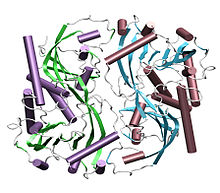- D-amino acid oxidase
-
D-amino-acid oxidase Identifiers EC number 1.4.3.3 CAS number 9000-88-8 Databases IntEnz IntEnz view BRENDA BRENDA entry ExPASy NiceZyme view KEGG KEGG entry MetaCyc metabolic pathway PRIAM profile PDB structures RCSB PDB PDBe PDBsum Gene Ontology AmiGO / EGO Search PMC articles PubMed articles D-amino-acid oxidase 
Identifiers Symbol DAO (DAAO) Entrez 1610 HUGO 2671 OMIM 124050 RefSeq NM_001917 UniProt P14920 Other data EC number 1.4.3.3 Locus Chr. 12 q24 D-amino acid oxidase (DAAO; also DAO, OXDA, DAMOX) is a peroxisomal enzyme containing FAD as cofactor that is expressed in a wide range of species from yeasts to human.[1] It is not present in bacteria or in plants. Its function is to oxidize D-amino acids to the corresponding imino acids, producing ammonia and hydrogen peroxide.
This enzyme belongs to the FAD dependent oxidoreductase family, and acts on the CH-NH2 group of D-amino acid donors with oxygen as acceptor. The enzyme is most active toward neutral D-amino acids, and not active toward acidic D-amino acids.
Recently, mammalian D-amino acid oxidase has been connected to the brain D-serine metabolism and to the regulation of the glutamatergic neurotransmission. In a postmortem study, the activity of DAAO was found to be two-fold higher in schizophrenia.[2]
DAAO is a candidate susceptibility gene[3] and together with G72 may play a role in the glutamatergic mechanisms of schizophrenia.[4]
DAAO is used as a biocatalyst in several biotechnological application, such as the oxidation of cephalosporin C, the deracemition of racemic D-amino acid solutions and as the biolocical component in several biosensors.
See also
External links
References
- ^ Pollegioni L, Piubelli L, Sacchi S, Pilone MS, Molla G (June 2007). "Physiological functions of D-amino acid oxidases: from yeast to humans". Cell. Mol. Life Sci. 64 (11): 1373–94. doi:10.1007/s00018-007-6558-4. PMID 17396222.
- ^ Madeira C, Freitas ME, Vargas-Lopes C, Wolosker H, Panizzutti R (April 2008). "Increased brain d-amino acid oxidase (DAAO) activity in schizophrenia". Schizophr. Res. 101 (1–3): 76–83. doi:10.1016/j.schres.2008.02.002. PMID 18378121. http://linkinghub.elsevier.com/retrieve/pii/S0920-9964(08)00097-2.
- ^ Gene Overview of All Published Schizophrenia-Association Studies for DAAO - SZGene database.
- ^ Boks MP, Rietkerk T, van de Beek MH, Sommer IE, de Koning TJ, Kahn RS (September 2007). "Reviewing the role of the genes G72 and DAAO in glutamate neurotransmission in schizophrenia". Eur Neuropsychopharmacol 17 (9): 567–72. doi:10.1016/j.euroneuro.2006.12.003. PMID 17250995. http://linkinghub.elsevier.com/retrieve/pii/S0924-977X(06)00260-4.
CH-NH2 oxidoreductases (EC 1.4) - primarily amino acid oxidoreductases 1.4.1: NAD/NADP acceptor 1.4.3: oxygen acceptor 1.4.4: disulfide acceptor 1.4.99: other acceptors Glycinergics Receptor
ligandsAgonistsAlanine • Cycloserine • Dimethylglycine • Glycine • Hypotaurine • Methylglycine (Sarcosine) • Milacemide • Serine • Taurine • Trimethylglycine (Betaine)Reuptake
inhibitorsPlasmalemmalGlyT1 inhibitorsGlyT2 inhibitorsVIAAT InhibitorsEnzyme
inhibitorsSHMT InhibitorsGDC InhibitorsDAAO InhibitorsOthers This oxidoreductase article is a stub. You can help Wikipedia by expanding it.
